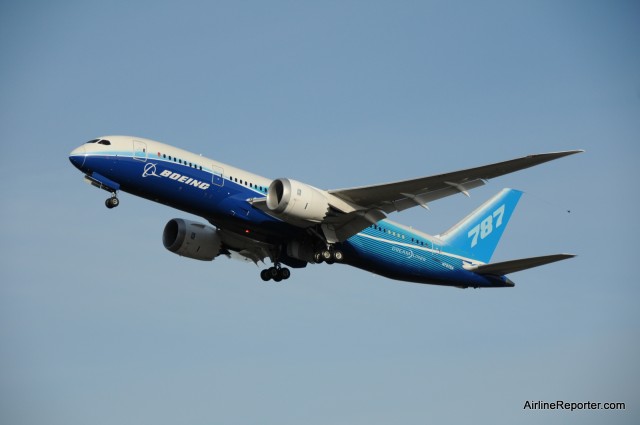
Boeing 787 Dreamliner ZA001. Check it out.
Do you like the Boeing 787 Dreamliner? Of course you do. Do you live in the Seattle area? Well, if you do come check out the very first Boeing 787 Dreamliner (ZA001) at the Museum of Flight on October 9th from 10am to 5pm. Here is the schedule:
10 am to 5 pm: 787 Number One on view in the Museum parking lot. Free. Up-close viewing with Museum admission. Flight simulators in the Museum’s Aviation Learning Center configured to fly like 787. Free with admission to the Museum.
11 am: Dreamliner Family Workshop. Free with admission to the Museum. ’œTip-to-Tail Tour’ of 787. Free with admission to the Museum.
1 pm: Dreamliner Family Workshop. Free with admission to the Museum.
1:30 pm: Lecture: Dreamliner Program Overview with Boeing Chief Pilot Randy Neville. A pilot who flew the plane on its historic first flight, Boeing Chief Pilot Randy Neville, will talk about the Dreamliner program during a 1:30 p.m. presentation at the Museum. Neville will provide an overview of the Dreamliner and its test flights. Since the maiden flight on Dec. 15, 2009, specially outfitted 787s have been actively flying in an extensive and demanding flight program to test the new technologies developed for Dreamliner. The 787 has since achieved FAA certification, and deliveries of new 787 airliners recently began on Sept. 26, 2011.
3 pm: ’œTip-to-Tail Tour’ of 787. Free with admission to the Museum.
Unfortunately, there will not be access to the interior of ZA001, but it doesn’t really have an interior anyhow, so that is okay. To learn more, check out the Museum of Flight’s website.
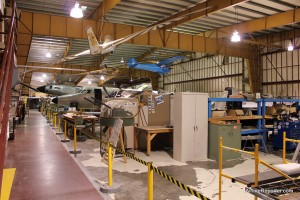
This is just one half of one of the hangars at the Museum of Flight's Restoration Center at Paine Field.
A while back I had the opportunity to check out the Museum of Flight at Boeing Field (KBFI), just south of Seattle. They have an amazing collection of aircraft and any aviation geek can find something of interest. They have vehicles on display that are covered in fabric to being found in space. Creating such an amazing collection doesn’t come easy and it takes an enormous amount of work to get old airplanes to museum quality. Where many visitors (and locals) will check out the Museum of Flight, many don’t get the whole story. A visit to check out the Museum of Flight Restoration Center, housed at Paine Field (KPAE), is a must for any aviation enthusiast.
The restoration work is mostly done by volunteers who use their time, skills and rarely even their own money to help restore the museum’s aircraft. These are people with a true passion for aviation and talking with them about their work is more exciting than viewing the actual airplanes. The facility employs only two staff, but has a roster of about 75 volunteers. The entire Aircraft Collections Department in Seattle and Everett, has a staff of three and over 125 volunteers. Volunteers will be broken up into teams and assigned to work on an aircraft. Director of Aircraft Collections and the Senior Curator will determine what needs to be done and work with the volunteers on the proper methods to do it. Since many parts can no longer be found or are too costly, in many cases, they end up making their own.
Restoring an airplane is difficult enough, but keeping it in good shape is a whole other ballgame. Most of the aircraft at the Museum of Flight and the Restoration Center are housed inside, which makes keeping them in prime condition easier. The challenge becomes the ones that live outside in the punishing Seattle weather. The Museum of Flight is in process of creating an indoor airpark to house the airliners that are outside now and the others (ie Comet, 1st 727 and Constellation) waiting to be put on display.
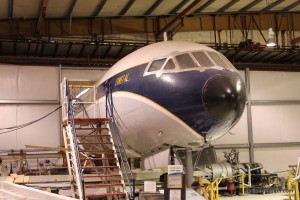
It becomes a challenging juggle between man-power, resources, money and time to keep such a large collection in pristine condition. The Restoration Center’s goal is not to get the aircraft to flying condition, but in a condition that they preserve the history of the aircraft type and of the individual plane. If the plane has damage on it, that can tell a story. They might not fully repair it since it is a part of the history of the aircraft.
Probably one of the most difficult tasks at the Museum of Flight or the Restoration Center is having to tell someone, “no,” when they have an aircraft that they want added to the collection. Boeing Field, where the Museum of Flight is located, is crowded and very expensive. Although the Restoration Center has been successfully expanding their hangar space at Paine Field throughout the years, it is becoming more difficult with the increased popularity.
Walking into the main lobby of the Restoration Center, you will find aviation related items almost everywhere. Although the lobby has some interesting things, it doesn’t compare to what you will find in the main hangar. When first entering the hangar, I had to pause and absorb everything. From old war birds, to military jets, to the front end of a Comet 4C sticking inside the hangar — I knew this was going to be a great visit. I am glad I had Tom Cathcart and TC Howard there to keep me on track or I might have just endlessly been wondering around the facility.
There are many wonderful planes with interesting stories (see all the photos), but here are three of my favorites:
THE DE HAVILLAND COMET 4C
I have seen the rear end of this plane sticking out of the hangar for many years, but had never made it inside. It is quite the site to see half the aircraft in the hangar and the rear half sticking out. This of course has caused some issues with the front being protected and the rear half being exposed to the elements. They are in the process of putting up a protective cover for the rear of the aircraft. This will make the view from outside less exciting, but it will keep the plane from deteriorating — which is well worth it.
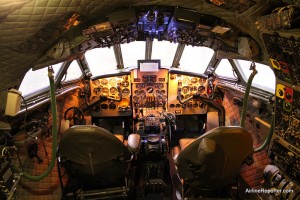
The wonderfully restored cockpit of the Comet 4C.
Stepping inside the Comet was like traveling through time. As I climbed on board, I tried to imagine what it must had been like for passengers to fly on a Comet for the first time. The Comet was the first production jet airliner and was a huge difference from their prop counterparts. What excitement passengers must have felt flying on a new generation or airliner. Yes, the Comet had some “breaking up in midair” issues at first, but by the time the Comet 4C came around, they had that sorted out.
This aircraft is being restored from the front to the back, which provides a nice insight on the process. The lavatory looked almost brand new and it was surreal seeing the photo on the wall showing what it looked like when they got the aircraft.
This exact aircraft (C/N 6424) had her first flight on October 31, 1959 and was delivered to Mexicana in July of 1960. The airplane was abandoned at Paine Field in 1979 before it was taken by Everett Community College for their students to work on. The problem was, it was a British aircraft and provided little help for American students learning how to work on American aircraft. Here is some more to explore:
* My photos of the Comet 4C during my visit
* More about the Comet 4C on the Museum of Flight’s website
* Some photos of the Comet’s restoration on Bob Bogash’s page
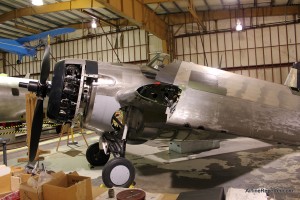
The Wildcat where you can see the new skin they put on versus the original on the wing.
THE FM-2 WILDCAT
The Wildcat is one slick plane, but I was mostly fascinated with how they have been restoring it. Like many of the other planes the Restoration Center receives, the plane wasn’t in the best of shape — it has been sitting at a park for many years. Since parts are difficult, expensive and time consuming to come by, 60% of this aircraft has been re-done in-house. You could see how some of the old skin on the aircraft remained, but much of is has been recently re-fabricated and placed on the aircraft.
On a work table there was a drawing, a paper mock up and a formed wood piece all made to re-make a part of the wing. The volunteers working there are a very creative and motivated group of people.
THE FIRST BOEING 727 (N7001U)
Ah, the first aircraft of a particular aircraft type is always a fun find. The Boeing 727-100 housed in the back of the Museum of Flight’s Restoration Center is N7001U and was the first 727 ever produced. After completing her flight testing, she served a long career with United Airlines. Unlike most other Boeing test programs, there was no dedicated test aircraft for the 727 program. The first one built was used for testing and then put into service.
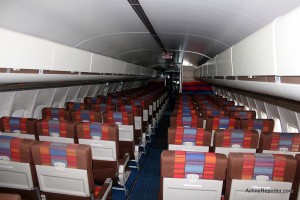
The interior of the 727 looks almost like it did when it was delivered. Can you see the obvious difference?
The plane was delivered to United on October 6, 1964 and after her long career, was delivered to the Museum of Flight in January 1991. Between that time, the aircraft flew almost 65,000 hours, made over 48,000 landings and few about 3 million passengers. The plane was configured to have the same livery and interior it had when it was first sold to United in 1964. At the time, the aircraft was gorgeous and still flight worthy. Unfortunatly United ended up removing many parts needed to keep the aircraft airborne and the Restoration Center has been working since to get this beauty back in the air.
That’s right. The goal is not to just to keep the aircraft in good shape, but also to get it where she can be flown from the Restoration Center at Paine Field, south about 30 miles to Boeing Field. It is a race against time to put new parts on the airplane while making sure it stays in good condition. In the past five years they have gotten parts donated from Clay Lacey’s old Boeing 727-200 (the cockpit is on display at the Future of Flight) and from Marcella, the Eastern Air Lines turned FedEx Boeing 727-200, whose front end is housed at the Future of Flight.
Much like walking into the Comet, the interior of the Boeing 727 takes you back in time. The colorful seats, the brown wallpaper and of course that very colorful carpet on the bulkhead. The cockpit looked like she was ready to fly and hopefully someday she might get that chance. Here is some additional information and photos of N7001U:
* My photos of N7001U inside and out
* Photos and information on the first 727 on the Museum of Flight’s site
* Additional information from Bob Bogash’s site
* Photo of the 727 in United Airline Tulip Livery
* Photo of the 727 in United Friendship Livery
The Restoration Center is not just a great place to visit, but to also learn how the restoration process works. I know many of you that read this blog have skills that could be very useful with many of their projects. If you are looking for something to do to keep you busy and you want to help out with history, the Restoration Center is always looking for dedicated people to help out. Otherwise, you are always welcome to visit (it only costs $5) to see the restoration process for yourself.
If you want more eye candy, be sure to check out the additional photos. This review will be added to my Aviation in Seattle page.
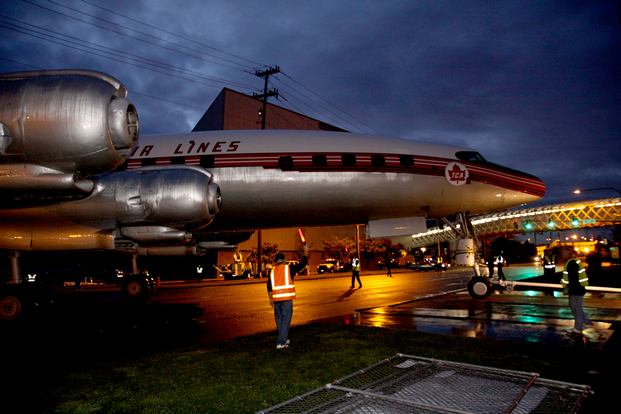
The Seattle Museum of Flight's Lockheed 1049G Super Constellation (CF-TGE) is towed across East Marginal Way South from Boeing Field into the museum's Airpark. (Ted Huetter/Museum of Flight)
Ah lack of sleep, it bites. Early Saturday morning (we are talking 3am), I was set up to head down to the Boeing Plant Building 2 to check out restored aircraft being stored by the Museum of Flight. Lack of sleep and a full day of activity (flying back from Atlanta), I totally slept through my alarm at 2am…oops.
Luckily, Ted Huetter with the Museum of Flight did not have the same problem and was able to share some photos.
Historic Plant 2 is famous for building so many bombers for World War II. The plant is set to be destroyed to make better use of the land. Inside the plant lived a B-17, B-29 and aLockheed Super Constellation all owned by the Museum of Flight.
Boeing isn’t saying when the building needs to come down, but they gave notice to the Museum of Flight they need to move their planes.
The planes had to cross a busy road and how do you go about doing that? Well, you do it at 3am…that’s how. All three aircraft were moved from old Plant 2 to the museum. The B-29 was moved to a ramp outside of Hangar 7 at Galvin Aviation and will be stored temporarily. The B-17 is being stored in a hangar at Clay Lacy Aviation. Finally the Constellation will be stored at the Airpark.
MORE GOODIES:
* A few photos on the Museum of Flights Facebook
* 27 photos taken by the Museum of Flight on the Seattle PI
* Photo of Boeing Plant 2 from the water
* Destruction of Plant 2 to help environment restoration via Seattle PI
* Photo of the Super Constellation from 1959
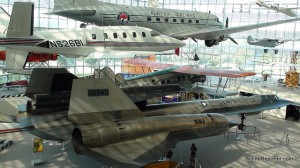
Alaska Airlines DC-3, Lear Fan 2100 hang from the ceiling, while an SR-71 and United Airlines Boeing 80A-1 hang out on the ground at the Museum of Flight
Over the past ten years I have (almost) consistently lived no farther than 30 miles away from the Museum of Flight (MoF) at Boeing Field in Seattle. However, I haven’t visited once in that last ten years. Being so close has been the problem. I have always thought, “well, I can go next weekend,” but I haven’t. I took such a wonderful aviation museum for granted and never went to re-discover what they have.
Well, I got sick and tired of hearing about all the cool new things they have and decided to go check them out myself. I was lucky to have Ted Huetter, Public Relations and Promotions Manager, show me around the place. Ted might work in PR, but there is no question he is an aviation nut and knows his stuff!
Last time I visited the MoF, they had a bunch of hanging airplanes (which don’t get me wrong are cool enough) and the old red Boeing barn. Today, not only do they have all that cool stuff still, but also their airpark, World War I and II displays and lots of nifty space stuff.
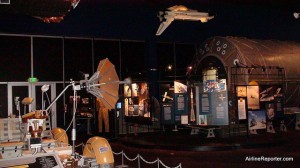
Lunar Rover on the left. Space station module on the right. Awesomeness all around.
The MoF started in 1964 when a small group of people set about wanting to maintain the history of aviation. The first aircraft obtained was displayed in the Seattle Center, where the Seattle Worlds Fair occurred in 1962. In 1975 the Port of Seattle leased the land the museum is currently on for 99 years (so better hurry before 2074). The Red Barn, which is the birthplace of The Boeing Company, was saved from demolition on its original location on the Duwamish River, and floated by river-barge to its current location.
The museum has a mission to “acquire and conserve a valuable collection of artifacts relating to air and space history and technology.” But they also want to ensure that the public can get access. This is a difficult mixture, since people are destructive. Not just the hooligans who literally cause damage, but just breathing and touching items or even air and sunlight can be very destructive over time. It is a hard balance of what aircraft to give patrons access to versus which ones must remain off-limits to keep them in tip-top condition over time.
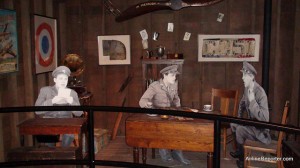
The Personal Courage Wing had much more than just airplanes. Really makes you feel like you travel back in time.
Even before I was able to make it into the lobby I was presented with eye candy outside. First they have a few aircraft on display, second you are right on Boeing Field, where the new test Boeing 787 Dreamliners and Boeing 747-8Fs are being housed, and lastly there were three Boeing 737-800 fuselages that were sitting on a train just outside the museum coming from Kansas and on their way to Renton, WA to be assembled.
After making it into the lobby you not only see aircraft hanging from the ceiling, but a vast gift shop with lots of great aviation related items (Even though Visa really wanted me to visit, I stayed away). They also have a theater off the lobby with great short movies, that you could probably just sit and watch all day without going through the rest of the museum.
When you first walk into the main “admissions only” area, you can’t help but get goose bumps. There are so many amazing aircraft hanging from the ceiling and on the ground for you to check out. From the SR-71 Blackbird to a DC-3 with Alaska Airlines livery. If you like aviation, you are going to love the collection of commercial and military aircraft they have on display.
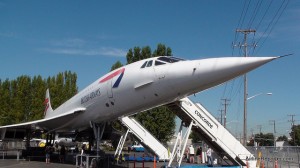
British Airways Concorde G-BOAG in the airpark
Off from the main floor is their Rendezvous in Space area and what a cool section. From a lunar rover to a full mock-up of a space station module that you can go inside of. The module is very interesting because there is no obvious “up.” Since there is no gravity, there is no floor and the signage for the buttons reads in different directions.
The way they have the area set up, it really puts you in a space-like setting, which makes the experience all that much more enjoyable. The museum is currently working to bring one of the space shuttles to their facility. You can sign a petition or donate to help their efforts and help Seattle get a Space Shuttle — and what city wouldn’t want to get a Space Shuttle?
After checking out Rendezvous in Space, it was off to the Personal Courage Wing that looks at the history of World War I and II. This is a new addition to the museum with two stories of history. They not only display amazing aircraft from both wars, but also share much more history about the time period and really put the aircraft into perspective. Even if you don’t like airplanes, but enjoy history, you will love this section of the museum (double bonus if you like both).
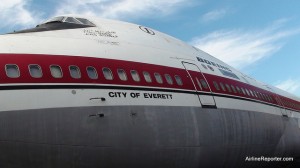
You are able to walk around the first ever Boeing 747, the City of Everett
My guide, Ted, told me that people always ask why World War II aircraft are downstairs (where you enter) and WWI are upstairs. He explained that it was all about weight. The aircraft from the earlier time period were much lighter than those from WWII, having it make more sense to store the lighter aircraft upstairs.
Now, it was time to head outside to their airpark to check out some pretty sweet airliners. First we went inside British Airways Concorde (G-BOAG). This was my first time inside a Concorde and it looked brand new still. The windows were super small and it was a little cramped, but not as bad as I expected. You are able to see in the cockpit and the few hundred fuses they have on the wall.
Having one of the remaining super-sonic airliners that is in such great shape is pretty exciting. Upon exiting, it was time to check out old Air Force One 707-120 that replaced Eisenhower’s Super Constellation. Ted explained that flight engineers, who used to work on the plane, recently came for a visit and they said the plane smells exactly the same as it did back in the day. Now, that is preserving history!
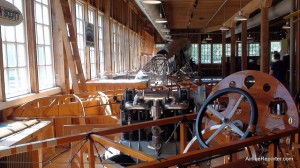
Inside the Boeing Red Barn at the Museum of Flight
Even though the Concorde and Boeing 707 are in pristine condition and you can go inside, the jewel of the airpark (in my opinion) is the first Boeing 747 (N7470). It is named the City of Everett after where it was built at Paine Field, located in Everett, WA. It first flew on February 9, 1969 and later served as a testbed for 747 systems improvements and new engine developments for other Boeing commercial jets, including the Boeing 777 engine program. She is not in the best shape, but that is something the Museum of Flight hopes to work on.
If you are into researching about planes, the MoF also has a public archive and library that you are able to visit. If you are in the Seattle area on October 9th or 10th, make your way to the Library and Archives Building, because they will be having a sale of a bunch of old aviation related books and other goodies.
There is so much more to explore at the MoF, an aviation nut could easily spend a few days there. For those of you who are local, it might be time to re-discover the Museum of Flight. For those of you that don’t live in the Seattle area, make sure to put this on your “must do” list and if you love aviation, you have to make it out to Seattle sometime to check out all the cool things we have to offer.
MORE PLEASE:
* 91 Photos I took during my trip
* Video with Harrison Ford (he loves aviation) promoting the Museum of Flight
* They have a vast collection of airline logos
* Friend the Museum of Flight on Facebook
* Follow them on Twitter
-
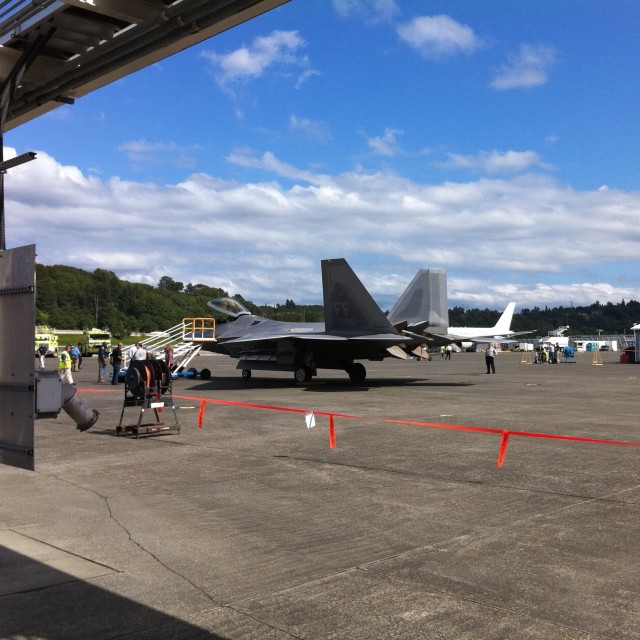
-
Back side of the F-22
-
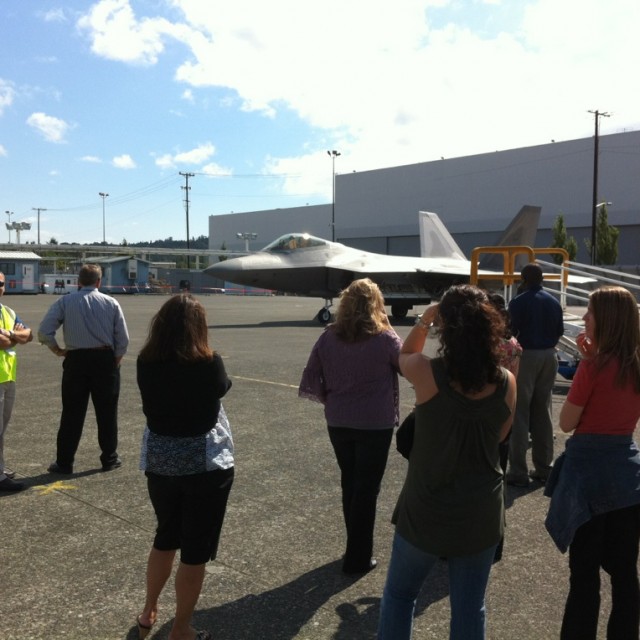
-
F-22 at Boeing Field
-
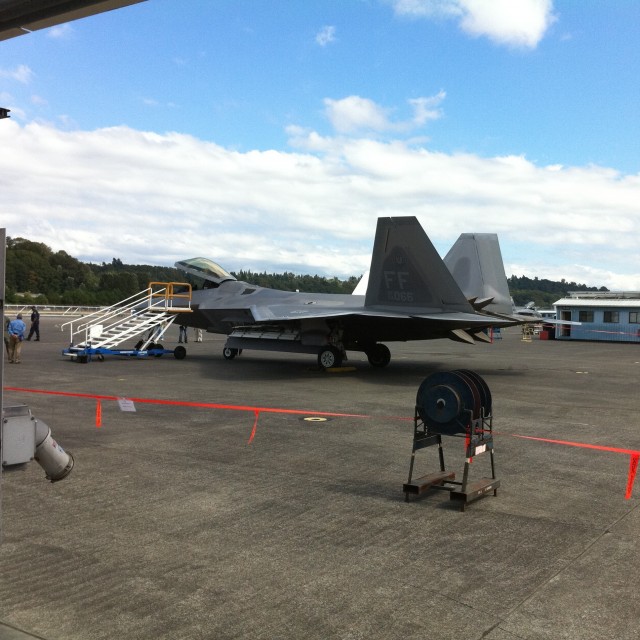
-
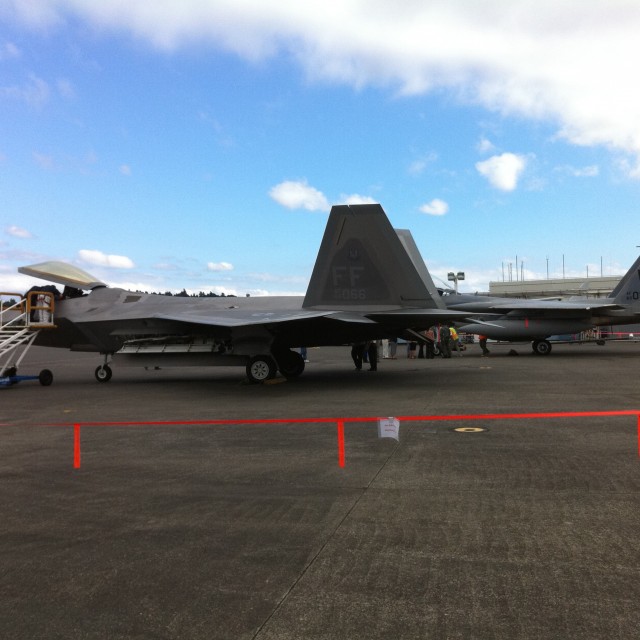
-
F-22 and F-15 at Boeing Field
Photos taken at Boeing Field of the F-22 by a friend just minutes ago. Click for larger versions. Thanks Nick!
Just got word that if you want to get a first hand glimpse of a F-22 Raptor, head on down to the Museum of Flight. Plane #66 will be on display next to the museum until Monday.
Update: The F-22 and F-15 will be on display for 478th fighter wing reunion.
















